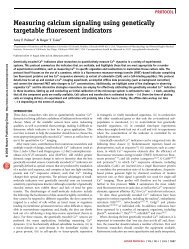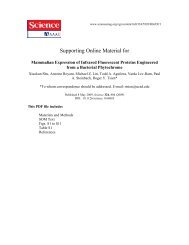THE GREEN FLUORESCENT PROTEIN - Tsien
THE GREEN FLUORESCENT PROTEIN - Tsien
THE GREEN FLUORESCENT PROTEIN - Tsien
Create successful ePaper yourself
Turn your PDF publications into a flip-book with our unique Google optimized e-Paper software.
540 TSIENFor example, an increase in excitation maximum to 540–550 nm would permitefficient energy transfer from terbium chelates, whose millisecond excited-statelifetimes make them useful as energy transfer donors (110). The 560–570 nmemission from such longer-wavelength GFP mutants would also be distinctenough from the standard class 2 (phenolate) mutants to make such greenorangepairs useful as FRET partners. Another approach to improving FRETwould be to reduce the emission bandwidth of the class 5 (tryptophan-based)cyan mutants and thereby improve the quantitative separation of cyan and yellowemissions. Emission spectral alterations should be most easily screened byfluorescence-activated cell sorting (FACS). The chemical structure of the redfluorescent species formed by intense illumination in anaerobic conditions (58)must be determined as the first step in making this extraordinary photochemicalreaction more general and useful.Altered Chemical and Photochemical SensitivitiesThe sensitivity of GFP spectra to environmental factors such as pH and pastillumination is valuable if pH indication or photochemical tagging is desiredbut is a nuisance for most other applications. Therefore we need to understandthe molecular mechanisms of such environmental modulations and to find mutationsthat enhance or eliminate those mechanisms. In many cases, it willbe important to use screening methods that, unlike FACS, permit longitudinalcomparison of individual cells or colonies before and after a chemical oractinic challenge. Digital imaging of colonies on plates (e.g. 111) is likely tobe advantageous.Fusions Other Than at N- or C-TerminusAlmost all fusions of host proteins with GFP have been simple tandem fusionsin which the C-terminus of one protein is genetically concatenated to the N-terminus of the other. Because not all such fusions work, general rules areneeded in order to predict when fluorescence will be intact and when host proteinfunction will be preserved. Sometimes neither order of simple concatenationproduces functional chimeras. Could splicing of GFP into the middle of thehost protein be made easier and more general? It might be helpful to engineerGFP to move its N- and C-terminii as close to each other as possible, perhapsby addition of spacers or by circular permutation.Alternatives to FluorescenceChromophores can be harnessed to perform many functions other than fluorescence,such as phosphorescence (emission from the triplet state), generation ofreactive oxygen species such as singlet oxygen or hydroxyl radical, and photochemicalcleavage. Can GFP be engineered to do such tricks? Phosphorescence






